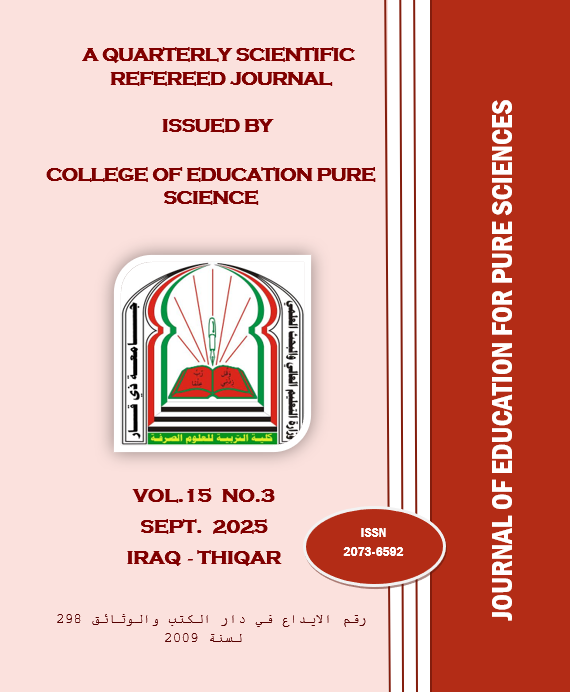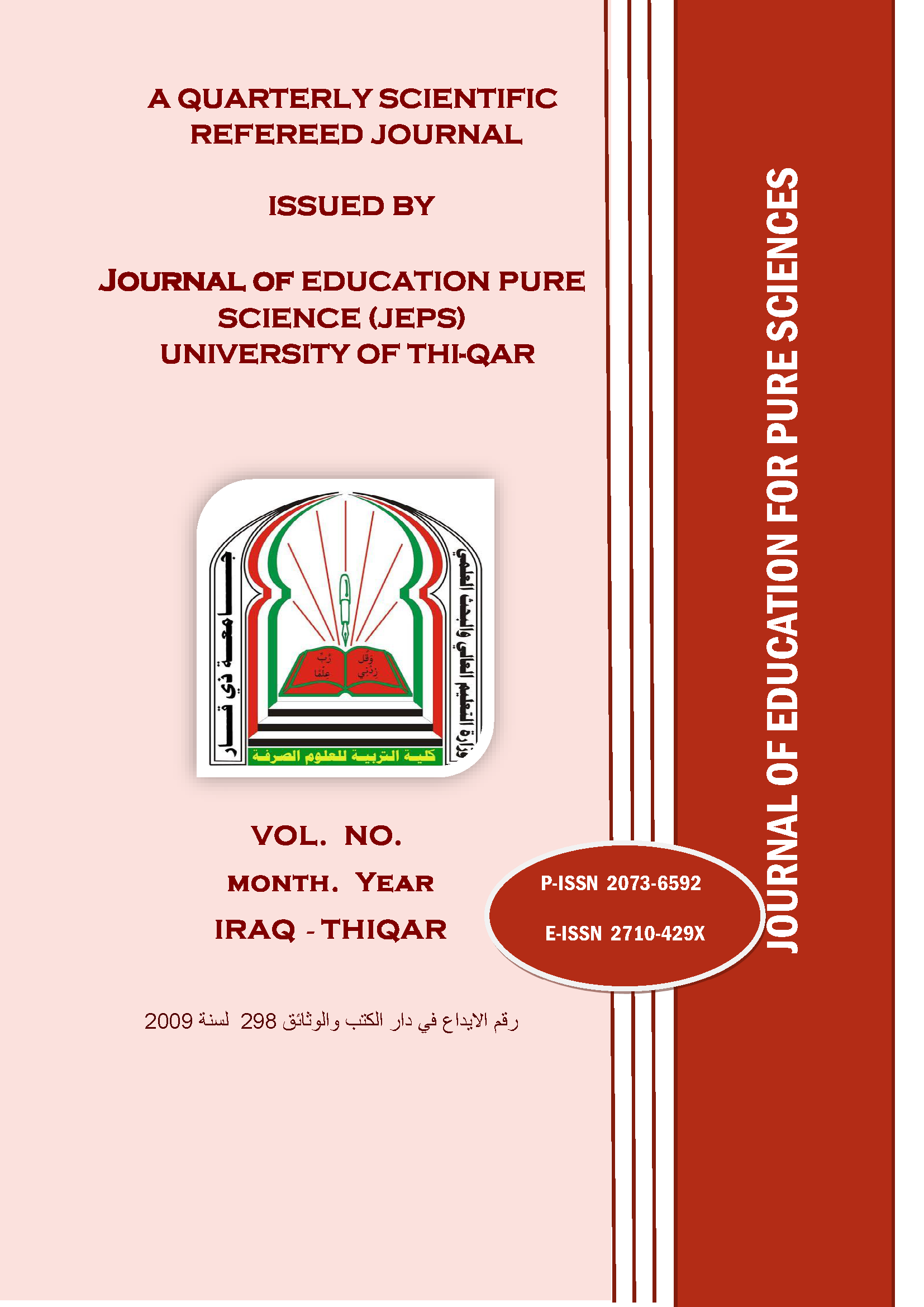The effect of plant extracts of Moringa Oleifera on Some Pathogens Isolated from the oral cavity of Diabetic mellitus type 2 Patients
DOI:
https://doi.org/10.32792/jeps.v15i3.577Abstract
The current study aims to examine or evaluate the biological activity of the plant extracts of Moringa oleifera in the Samawa governorate and the aerial parts of plants was extracted by a Soxhlet extractor, using two types of solvents are characterized by different polarity: methanol and hexane, and determine the active compounds by using Gas Chromatography Mass Spectrometry (GC-MS).The GC results for the Moringa extract with methanol showed 9 active compounds, while the Moringa extract with hexane showed 24 active compounds.
The antimicrobial activities of the crude extracts are tested against three species of pathogenic bacteria and fungi consisting of two gram positive bacteria: Streptococcus mutants Enterococcus feacalis and one fungus is Candida albicans, based on disc-diffusion assay and determine the Minimum extract four concentrations of each Inhibitory Concentration (MIC). Formed: (0, 25, 50, 75 mg/ml). Were the results of the inhibitory activity of the extracts varied according to the type of extract itself and the different bacteria tested? Generally, Moringa oleifera extracts show strong inhibition against all bacteria, and fungi, especially hexane extract and methanol
References
Topal, M., & Gülçin, İ. (2022). Evaluation of the in vitro antioxidant, antidiabetic and anticholinergic properties of rosmarinic acid from rosemary (Rosmarinus officinalis L.). Biocatalysis and Agricultural Biotechnology, 43, 102417.
Salihuet M., Muhammad, A., & Abdallah, M. S. (2019). Antibacterial activity of Moringa oleifera leaf extracts against bacteria isolated from patients attending General Sani Abacha Specialist Hospital Damaturu. Allied Pharmaceutical Sciences, 1, 61-66.
Moke, E. G., Umukoro, E. K., Okafo, S. E., Asiwe, J. N., Eduviere, A. T., Omorodion, L. I., ... & Eboye, R. (2023). The Role of Medicinal Plants in Diabetes Mellitus and Oxidative Stress: A Review. International Journal of Nutrition Sciences, 8(2), 74-83.
Deepthi B, Sowjanya K, Lidya B, et al. (2017). A modern review of diabetes mellitus: an annihilators metabolic disorder. J In Silliico In Vitro Pharmacol.
Pfützner, A., Schaedlich, M., Möller, P., Gupta, S., Pätilä, T., Räisänen, I. T., & Sorsa, T. A. (2023). The Oral-Systemic Link: A Review about the strong Correlation between Diabetes mellitus, Periodontitis and COVID-19 Outcome. Medical Research Archives, 11(1).
Schwartz, M., Canon, F., Feron, G., Neiers, F., & Gamero, A. (2021). Impact of oral microbiota on flavor perception: From food processing to in-mouth metabolization. Foods,
Dalmasso, M., De Haas, E., Neve, H., Strain, R., Cousin, F. J., Stockdale, S. R., Ross, R. P., & Hill, C. (2015). Isolation of a novel phage with activity against Streptococcus mutans Biofilms. Plos One, 10(9), e0138651.
Rohani, B. (2019). Oral manifestations in patients with diabetes mellitus. World journal of diabetes, 10(9), 485.
Kashyap, P., Kumar, S., Riar, C. S., Jindal, N., Baniwal, P., Guiné, R. P., ... & Kumar, H. (2022). Recent advances in Drumstick (Moringa oleifera) leaves bioactive compounds: Composition,healthbenefits,bioaccessibility,anddietaryapplications.Antioxidants,11(2), 402.
Nieto, G., Ros, G., & Castillo, J. (2018). Antioxidant and Antimicrobial Properties of Rosemary (Rosmarinus officinalis, L.): A Review. Medicines, 5(3), 98.
Rezaei, T., Mehramouz, B., Gholizadeh, P., Yousefi, L., Ganbarov, K., Ghotaslou, R., & Kafil, H.S.(2023). Factors associated with Streptococcus mutans pathogenicity in the oral cavity. Biointerface Res Appl Chem, 13(4), 368
Rohani, B. (2019). Oral manifestations in patients with diabetes mellitus. World journal of diabetes, 10(9), 485.
Downloads
Published
Issue
Section
License
Copyright (c) 2025 Journal of Education for Pure Science

This work is licensed under a Creative Commons Attribution-NonCommercial-NoDerivatives 4.0 International License.
The Authors understand that, the copyright of the articles shall be assigned to Journal of education for Pure Science (JEPS), University of Thi-Qar as publisher of the journal.
Copyright encompasses exclusive rights to reproduce and deliver the article in all form and media, including reprints, photographs, microfilms and any other similar reproductions, as well as translations. The reproduction of any part of this journal, its storage in databases and its transmission by any form or media, such as electronic, electrostatic and mechanical copies, photocopies, recordings, magnetic media, etc. , will be allowed only with a written permission from Journal of education for Pure Science (JEPS), University of Thi-Qar.
Journal of education for Pure Science (JEPS), University of Thi-Qar, the Editors and the Advisory International Editorial Board make every effort to ensure that no wrong or misleading data, opinions or statements be published in the journal. In any way, the contents of the articles and advertisements published in the Journal of education for Pure Science (JEPS), University of Thi-Qar are sole and exclusive responsibility of their respective authors and advertisers.





